Introduction
In the period since the Second World War, Peru has undergone the most far-reaching change in its history as a republic. This change has not been an isolated or planned event, but a succession of millions of incidents which have gradually transformed a seemingly immutable order.
Peru's cities have ceased to be small familiar places and become impersonal, heavily populated metropolises with new, unfamiliar neighborhoods.
In the past forty years, indigenous migration has quintupled the urban population and forced cities to reorganize. New activities have emerged and gradually replaced traditional ones. Modest homes cramped together on city perimeters, a myriad of workshops in their midst, armies of vendors hawking their wares on the streets, and countless minibus lines crisscrossing them—all seem to have sprung from nowhere, pushing the city's boundaries ever outward. Daily, a medley of smoke and odors from the fried food cooking on the streets blends with strains of Andean music. A steady stream of small craftsworkers, tools under their arms, expand the range of activities carried out in the city. Ingenious local adaptations add to the production of essential goods and services, dramatically transforming certain areas of manufacturing, retail distribution, building, and transportation. The surrounding desert and hills have ceased to be a passive landscape and themselves become part of the city, and the city's European style has yielded to a noisy, tawny skinned personality.
But the cities have also conferred individuality on their inhabitants. Individual effort has come to predominate over collective effort. New business owners have emerged who, unlike their predecessors, are of popular origin. Upward mobility has increased. The patterns of consumption and exclusive luxuries of the old urban society have been displaced by other, more widespread, ones. In entertainment, for instance, opera, theater, and zarzuela have been replaced over the years by the cinema, soccer, folk festivals and, most recently, television. Likewise, consumer goods such as beer, rice, and table salt have been brought within everyone's reach, while consumption of the more expensive items, such as wine and meat, has declined over the decades.
There have been significant changes in the Peruvians' religious habits, too. Catholicism, identified with the traditional order, has lost ground to newer religious movements such as Protestantism, the Charismatics and, more recently, such vernacular and syncretic expressions as the Asociación Evangélica de la Misión Israelita del Nuevo Pacto Universal. Popular saints like la Melchorita or Sarita Colonia, who are not recognized by the Church, are replacing Santa Rosa de Lima and other traditional saints in local devotions.
The result is a new cultural identity which needs to be portrayed in social terms. The emergence of chicha music, which is replacing Andean folk music and Creole music, and the success of certain forms of communication—radio programs and television soap operas which refer to or reflect definite elements of this new identity—are clear examples of this change. Society pages and television programs devoted to the life-style of the upper classes have gradually disappeared, and crime series and programs featuring popular entertainment, which the nostalgic dismiss as vulgar, are now preferred viewing.
People have also begun to invest more in their education. The proportion of students of popular origin in secondary schools and schools of higher education has increased significantly, and in the former mansions of the aristocracy all kinds of academies and institutes offer cheap, practical training in an endless variety of subjects.
The upper classes have discovered that they must henceforth rub shoulders with people of popular origin in restaurants and airplanes, on beaches, on boards of directors, and even in the government. Many of them have chosen to retreat into their own, steadily shrinking, world and console themselves with memories of a bygone age. There are those who entrench themselves in exclusive residential neighborhoods, frequent clubs where time seems to have stood still, drive whenever possible only on tree-lined avenues, and preserve customs which consign them to de facto social and racial segregation.
New organizations have emerged in an attempt to restore or reformulate some of the values and attachments that were being lost. Over the years, regional, church, and sports clubs, neighborhood committees, street vendors' associations, and even transport operators' committees have tried to secure the well-being of their members. In the cities, the extended family has been transformed into a network of commercial or productive relations: economic activities conducted among "cousins" and "uncles" are now commonplace.
As the economic activities with which they are associated have grown, these organizations have also begun to play a dominant role in relation to the state. Thus, the provision of such basic infrastructures as roads, water supply, sewage systems, and electricity, the construction of markets, the provision of transport services, and even the administration of justice and the maintenance of law and order have, to varying degrees, ceased to be the exclusive responsibility of the state and are now also offered by these new organizations. And as the state's role has diminished, so too has that of traditional society. With new organizations gradually gaining ascendancy, the old unions have lost ground and membership in trade unions has dropped steadily, today accounting for only 4.8 percent of the economically active population.
What is disturbing is that only part of the ground relinquished by the state has been occupied by these new organizations. The rest appears to have been taken over by violence. Attacks, kidnappings, rapes, and murders have coincided with increasingly aggressive driving habits and unsafe streets. The police have gradually lost control of the situation and some of their members have been involved in scandals and become seasoned criminals. Overcrowding and promiscuity in the prisons foster bloodshed and increased criminality which spreads throughout the city when prisoners escape, sometimes with the complicity of their guards. The resulting violence has forced people to defend themselves as best they can: all kinds of weapons, including machine guns and automatic shotguns, watchmen in various uniforms, and even inscrutable bodyguards, are now commonplace. With each day that passes, we come closer to resembling the offensive movie stereotype of the banana republic.
People have gradually grown used to living outside the law. Theft, illegal seizure, and factory takeovers have become everyday occurrences and do not greatly disturb people's consciences. Thanks to constant whitewashing, some criminals have become public figures.
A complete subversion of means and ends has turned the life of Peruvian society upside down, to the point that there are acts which, although officially criminal, are no longer condemned by the collective consciousness. Smuggling is a case in point. Everyone, from the aristocratic lady to the humblest man, acquires smuggled goods. No one has any scruples about it; on the contrary, it is viewed as a kind of challenge to individual ingenuity or as revenge against the state.
This infiltration of violence and criminality into everyday life has been accompanied by increasing poverty and deprivation. In general terms, Peruvians' real average income had declined steadily over the last ten years and is now at the level of twenty years ago. Mountains of garbage pile up on all sides. Night and day, legions of beggars, car washers, and scavengers besiege passersby, asking for money. The mentally ill swarm naked in the streets, stinking of urine. Children, single mothers, and cripples beg for alms on every street corner.
Civilian interest in public matters has also begun to grow. Such issues as inflation, devaluation, and the external debt are no longer mysteries to which certain members of the elite hold the key, but have become topics of discussion on which everyone has something to say. Governments must now submit their actions to public opinion and the public's acceptance or rejection has become a political force which can affect government stability.
In this situation, more Peruvians have learned to negotiate with the state for all manner of privileges which will enable them to overcome their difficulties, something which has led to an increasing politicization of our society. Small interest groups fight among themselves, cause bankruptcies, implicate public officials. Governments hand out privileges. The law is used to give and take away far more than morality permits. Many media of information are dependent on state assistance or state banks and therefore bow to the powers-that-be, surrendering their ability to denounce abuses or even describe events objectively. Increasingly, more than one source of information is needed to obtain a true idea of the facts.
This state of affairs has brought about a sharp change of attitude toward society. Terrorism has emerged as a violent alternative to the present situation, but a new attitude to things Peruvian has also emerged. It is as though the country's intelligentsia were seeking refuge in the idyllic innocence of the Andean people, a people uncorrupted by all this decadence. The terrorist movement itself proposes to wage "popular warfare from the countryside to the cities," as if the regenerative force for change has to come from Peru's inner depths.
Things have changed in Peru. Although life goes on as it has for centuries in some parts of the country, it is in the cities that today's history is being written. It is there, rather than in the countryside, that we must look for the meaning of, or the answer to, the changes that have taken place. The present has finally prevailed. Nothing will be as it was; the past will not return.
Migration
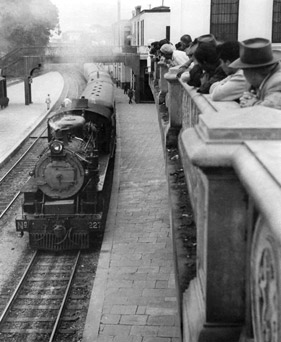
THE TREK FROM VILLAGES TO THE CITY. NEWS MIGRANTS TO LIMA FUEL THE INFORMAL ECONOMY WITH THEIR ARRIVAL AT DESAMPARADOS (THE ABANDONED ONES), 1969. PHOTO CARLOS DOMINGUEZ
All these changes began when the population of self-reliant farming communities began to move to the cities, reversing the long historical trend that had kept them in isolation. As we have already seen, between 1940 and 1981 Peru's urban population increased almost fivefold (from 2.4 to 11.6 million), while its rural population increased barely a third (from 4.7 to 6.2 million). Thus, while 65 percent of the population lived in rural areas and 35 percent in urban areas in 1940, these percentages had been reversed by 1981. To put it more simply, in 1940, two of every three Peruvians lived in the countryside, but by 1981 two of every three lived in the city.
If we consider that, in 1700, the rural population was 85 percent of the total population and the urban population accounted for only 15 percent, and that, by 1876, the population living in rural areas still accounted for 80 percent as against 20 percent in the cities, the dramatic change of the last forty years becomes even more striking. The historical predominance of the rural population has been reversed in favor of the urban population, housing conditions have altered dramatically, and the transition has been made from an agricultural to an urban civilization.
Generally speaking, Peru's urbanization dates back to the mass migrations from the countryside to the city, which began to be recorded in the national statistics in 1940 but actually started a little earlier. This urbanization coincided with a rapid growth of the population throughout the country. Growth had hitherto been fairly slow. While not entirely accurate, the national censuses of the last two centuries reveal an average growth of 0.6 percent. In this century, on the other hand, the total population grew more than two-and-a-half times between 1940 and 1981, from 7 million to almost 18 million.
The increase was substantially greater in Lima. The population of the capital city multiplied by 7.6 times during this period. In 1940, it housed 8.6 percent of the country's population; it now contains 26 percent. The number of migrants to Lima increased over 6.3 times, from 300,000 to 1,900,000, between 1940 and 1981.
The numerical impact of migration on the growth of the capital city was greater than the actual number of migrants, however, since the fertility rate was higher among migrant women than among city-born women, and their children's mortality rates were lower than they would have been in the countryside. This can be illustrated by an example: in 1981, Lima would have had a population of only 1,445,000, instead of the 4 million recorded by the census, if there had been no migration after 1940. Or, to put it another way: in 1981, two-thirds of Lima's population were migrants or children of migrants, while the remaining third were actual natives of the city. Migration is thus a key factor in explaining the changes that have occurred. But we still have to explain why these migrations took place. Like most social phenomena, it has many causes.
The most visible one is the building of highways. After the War of the Pacific a century ago, a complete reorganization of Peru was undertaken, which included providing the country with a highway system instead of improving railways or coastal facilities that had been the traditional modes of transport. At the beginning of this century, Peru had only 2,500 miles of highway; by 1981, it had roughly 37,500 miles. In the intervening period, the Highways Conscription Act, adopted in 1920, and plans for a national highway, among other policies, transformed the unconnected roads built over old Inca and colonial paths into a proper highway system that became the material base essential for mass migration and which also awoke, in the rural population, an increasing desire to move to the cities.
The subsequent development of other means of communication provided an additional incentive for increased migration. By publicizing, from thousands of miles away, the opportunities, amenities, and comforts of urban life, radio in particular aroused all kinds of enthusiastic reactions—above all, expectations of increased consumption and income. Civilization was, so to speak, being offered to anyone with the courage to take it.
There is also fairly widespread agreement in academic circles that the agricultural crisis of 1940 to 1945 was another decisive factor. The modernization of agriculture and the uncertain market for sugar and cotton following the Second World War triggered massive layoffs of farm laborers on the traditional mountain estates and the large industrialized farms of the coast, unleashing a vast contingent of people who were prepared to leave in search of new horizons.
The impact of the agricultural crisis on migration can also be traced to the problem of property rights in the countryside.1 The traditional difficulties of acquiring agricultural land were compounded—and ultimately exacerbated—when, in the 1950s, there began what would prove to be a long, continuous, and unstable process of agrarian reform. Unable to own land or find work in the countryside, many people chose to migrate to the cities in an attempt to acquire the property hitherto denied them and thereby satisfy some of their material aspirations.
The lower infant mortality rate in Lima was also a powerful incentive to leave the countryside. Over the decades, mortality rates had always been lower in the capital city than in the rest of the country. While in 1940 the national infant mortality rate was 181 per 1,000 children, Lima's rate was 160. This gap widened as medical services expanded; by 1981, the national infant mortality rate was 98 per 1,000, while in Lima it was 44. This incentive to migrate thus increased with time.
Better wages were also an important incentive. By 1970, people leaving the countryside to take up semiskilled employment in Lima could, on average, triple their monthly income. Salary earners could quadruple their previous income, and professionals or technicians could earn six times as much. Higher pay offset the risk of unemployment: an average migrant who had been unemployed for a year could recoup the lost income by working for two and a half months in the city. A migrant unemployed for two years could recoup the lost income in a little over four months, and so on.
Last, but not least, the growth of the government bureaucracy and the possibility of obtaining a better education were also powerful incentives for moving to the city. The centralization of redistributive power, the feeling of being close to political decision making, the urban location of most of the government offices competent to provide advice, answer requests, or issue permits, and the possibility of finding employment in its ranks, turned the burgeoning government bureaucracy into an added incentive for abandoning rural life.
And, until recently, 45 percent of secondary school graduates, 49 percent of students enrolled in vocational training centers, 46 percent of those enrolled in schools and institutes of higher education, and 62 percent and 55 percent, respectively, of university applicants and entrants were to be found in Lima. To peasants whose only capital is themselves, education seems a valuable and productive investment.
These concurrent facts suggest that migration was not an irrational act undertaken on a whim or out of a herd instinct, but rather the result of a rational assessment by the rural population of the opportunities open to them. No matter how rightly or wrongly, they made their decisions in the belief that migration would benefit them.
A Hostile Reception
When they arrived in the cities, however, migrants encountered a hostile world. They soon realized that, while formal society had a bucolic vision of Peru's rural world and acknowledged its right to happiness, no one wanted that other world to descend on the cities. Assistance and development programs for rural areas were designed to ensure that the peasants improved their lot where they were, well away from the cities. Civilization was expected to go to the countryside; the peasants were not expected to come looking for it.
The hostility was extreme. In the 1930s, a ban was imposed on the construction of cheap apartments in Lima. There are those who recall that, in the early 1940s, President Manuel Prado considered a curious proposal for "improving the race" which involved encouraging the migration of Scandinavians to the country's cities. In the 1946 legislature, the senator for Junín, Manuel Faura, presented a bill that would have prohibited people from the provinces, particularly from the mountains, from entering Lima. In the next legislature, Representative Salomón Sánchez Burga submitted a request, with the House's approval, which would have required people wishing to enter the capital from the provinces to carry an entry passport. All these proposals failed, but they show that, even then, there was a clear desire to deny migrants access to the city.
Nor was it strange that these politicians should react thus. From their beginnings, Peru's cities had been administrative and religious centers whose mission was to bring order to a wild and rustic land. Cities represented the cosmos in the midst of chaos. As a result, their latter-day inhabitants, heirs to the old Andean and Spanish tradition, could not react with anything but horror to the migration from the countryside, for chaos was finally invading their cosmos. Moreover, each person who migrates to the capital is in some way a potential competitor and it is natural inclination to try to avoid competition.
However, the greatest hostility the migrants encountered was from the legal system. Up to then, the system had been able to absorb or ignore the migrants because the small groups who came were hardly likely to upset the status quo. As the number of migrants grew, however, the system could no longer remain disinterested. When large groups of migrants reached the cities, they found themselves barred from legally established social and economic activities. It was tremendously difficult for them to acquire access to housing and an education and, above all, enter business or find a job. Quite simply, Peru's legal institutions had been developed over the years to meet the needs and bolster the privileges of certain dominant groups in the cities and to isolate the peasants geographically in rural areas. As long as this system worked, the implicit legal discrimination was not apparent. Once the peasants settled in the cities, however, the law began to lose social relevance.
The migrants discovered that their numbers were considerable, that the system was not prepared to accept them, that more and more barriers were being erected against them, that they had to fight to extract every right from an unwilling establishment, that they were excluded from the facilities and benefits offered by the law, and that, ultimately, the only guarantee of their freedom and prosperity lay in their own hands. In short, they discovered that they must compete not only against people but also against the system.
From Migrants to Informals
Thus it was, that in order to survive, the migrants became informals. If they were to live, trade, manufacture, transport, or even consume, the cities' new inhabitants had to do so illegally. Such illegality was not antisocial in intent, like trafficking in drugs, theft, or abduction, but was designed to achieve such essentially legal objectives as building a house, providing a service, or developing a business. As we shall see later, it is more than likely that, economically speaking, the people directly involved in these activities (as well as society in general) are better off when they violate the laws than when they respect them. We can say that informal activities burgeon when the legal system imposes rules which exceed the socially accepted legal framework—does not honor the expectations, choices, and preferences of those whom it does not admit within its framework—and when the state does not have sufficient coercive authority.
The concept of informality used in this book is based on empirical observation of the phenomenon itself. Individuals are not informal; their actions and activities are. Nor do those who operate informally comprise a precise or static sector of society; they live within a gray area which has a long frontier with the legal world and in which individuals take refuge when the cost of obeying the law outweighs the benefit. Only rarely does informality mean breaking all the laws; most individuals disobey specific legal provisions in a way that we shall describe later. There are activities for which the state has created an exceptional legal system through which informals can pursue their activities, although without necessarily acquiring a legal status equivalent to that of the people who enjoy the protection and benefits of the entire Peruvian legal system; these are also informal activities.
This is a book which tells the story of the migrants who have become informals during the past forty years and which attempts to show why we have come to be a country in which 48 percent of the economically active population and 61.2 percent of work hours are devoted to informal activities which contribute 38.9 percent of the gross domestic product (GDP) recorded in the national accounts. It is a book which tries to explain the reasons and the prospects for the change which is taking place in Peru by analyzing the vanguard of this change, the informals. It also tries to explain why our legal institutions have been unable to adapt to this change, with the result that, despite an average productivity equivalent to only a third of that of the formal sector, informal economic activity will continue to grow and by the year 2000 can be expected to generate 61.3 percent of the GDP recorded in the national accounts. It also shows how the new institutions developed by the informals provide a coherent alternative on which a different order, open to all Peruvians, can be based. It is also, of course, a book which proposes solutions.
In the first part of the book, consisting of this chapter and the three that follow, we describe the world which we gradually discovered in the past six years as we visited, in turn, informals and their formal counterparts. On the basis of these observations and the findings of other researchers, we describe how, in three specific sectors—housing, transport, and trade— where the Instituto Libertad y Democracia (ILD) has been able to complete its research, the informals have won a space for themselves and are gradually taking over most of the market, appropriating land on which to live and produce, setting up on the streets as vendors in order to work, or invading the cities' main thoroughfares in order to provide transport services. In all these cases they have openly disobeyed the law and defied institutions, creating a breach through which the rest of society is also deserting the formal sector. As the informals have advanced, the Peruvian state has fallen back, viewing each concession as temporary, "until the crisis is over," when in fact it is being forced to adopt a strategy of steady retreat, a retreat that is gradually undermining its social relevance.
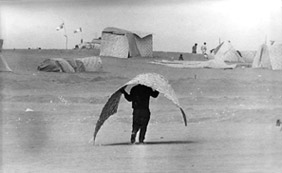
BIRTH OF AN INFORMAL SETTLEMENT IN 1971. PAMPLONA, PHOTO: EL COMERCIO ARCHIVE.
The first part of this book describes how el Perú profundo, "the unknown Peru," began a long and sustained battle to integrate itself into formal life, a battle so gradual that its effects are only just beginning to be seen. We appear to be witnessing the most important rebellion against the status quo ever waged in the history of independent Peru.
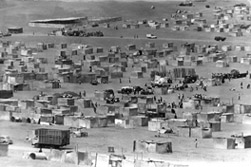
FIRST SIGNS OF CITY PLANNING. THE TOWNSHIP OF MY PERU. PHOTO: EL COMERCIO ARCHIVE.
The early chapters are devoted to Lima. In the first chapter, we show how, through invasions or illegal acquisitions of land, neighborhoods sprang up which today account for 42.6 percent of all housing in Lima and are home to 47 percent of the city's population. Such housing, built by illegal settlers at a cost of years of sacrifice, is today valued at $8,319.8 million. It demonstrates only part of the informals' tremendous ability to generate wealth.
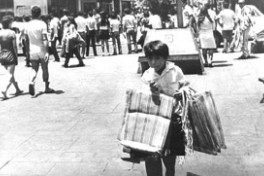
THE CLASSIC STREET PEDDLER IN DOWNTOWN LIMA, CARRYING HIS WARES. PHOTO: EL COMERCIO ARCHIVE
In the second chapter, we describe how Lima's 91,455 street vendors dominate the retail distribution of popular consumer goods in the capital and how they maintain a little over 314,000 relatives and dependents.
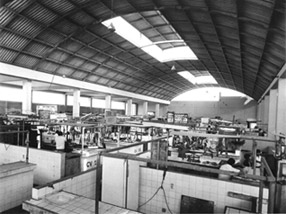
THE INFORMAL MARKET. PHOTO: JOSE CASAIS.
In addition, in order to move off the streets, and in the face of countless restrictions, 39,000 other vendors have managed to build or acquire 274 informal markets valued at $40.9 million.
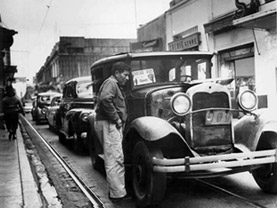
THE OLD 'COLECTIVOS', PRIVATE SEDANS RUN AS INFORMAL TRANSPORTATION. PHOTO:CARETAS ARCHIVE
In the third chapter we show how, by invading routes, informals have managed to gain control of 93 percent of the urban transport fleet, and 80 percent of its seats. We also describe how these informals spontaneously designed the transport routes which now serve Lima.
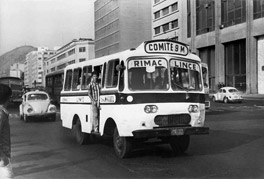
THE FIRST MINIBUS. PHOTO CARETAS ARCHIVE
The first part of this book contains other information as well. We describe how the informals, rather than surrender to anarchy, developed their own laws and institutions, which we call the "system of extralegal norms," to make up for the shortcomings of the official legal system. They created an alternative order to that of the formal sector. We also recount the epic struggle waged by the informals in recent decades, their confrontations and alliances with the state, their relationships with politicians, and their incorporation into the landscape of our city.
Lastly, in these chapters we analyze how the informals have converted invasion into an alternative means of expressing the value of things and how their apparently superficial decisions are based on a fairly complex rationale. In short, in these chapters we try to explain the logic implicit in the functioning of informality.
The second part of the book is an analytical exercise which shows how the different costs in our society are a result of the way the law is conceived and made, as if wealth were a stock whose shares are to be redistributed by the state to different pressure groups.
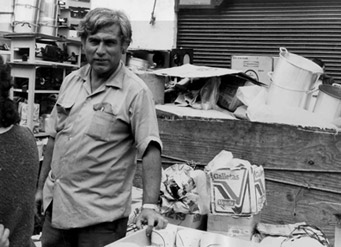
ROBERTO ARAUJO ESPINOSA, LEADER OF THE FEDERATION OF STREET VENDORS. PHOTO CARLOS DOMINGUEZ
This way of governing suggests a significant historical parallel with mercantilism, the system which guided European economic and social policies from the fifteenth to the nineteenth century.
The most difficult pages in this part of the book are those devoted to identifying, measuring, and classifying existing costs. They describe the costs of enjoying the protection of the law and the way in which these costs affect people's access to and ability to remain in different economic activities.
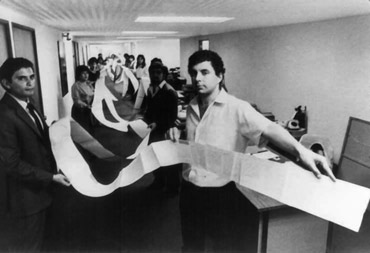
THE FORMAL PATH. THE FORMAL PROCEDURES NEEDED TO SET UP A SMALL INDUSTRY. PHOTO: CARETAS ARCHIVE
They also describe the costs and losses to the country when people do not enjoy the protection of this law. These pages thus show the importance of legal institutions in explaining the poverty and violence, the new cultural trends, informality, and the retreat of the state—in other words, in explaining the changes in our society.
Chapters 6 and 7, on the redistributive tradition and mercantilism, enable us to present one of the key arguments of this book, namely, that mercantilism—and not feudalism or the market economy—constituted Peru's economic and social system after the arrival of the Spaniards. The emergence of a growing and thriving informality is a revolt against mercantilism and is hastening its ultimate demise. In the final chapter, we offer some conclusions about Peru's future and possible ways to solve its present crisis.
It will be easy to judge the accuracy of the account given in the pages that follow, for everything happened as we were observing it. There is nothing in this book that needs to be confirmed by complex laboratory experiments. You have only to open the window or step into the street.
Nonetheless, since we lack the distance in time to judge fully what has happened, this book cannot be called a scientific history. It is a political book which is based on evidence and will doubtless need to be rewritten some years from now. But this does not make it any less a book which seeks to offer guidance and, above all, to show that there is hope amidst all the apparent disaster, a hope based on the creativity and energy of Peruvians who have yet to find an appropriate legal and institutional framework for their development.
